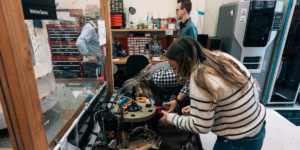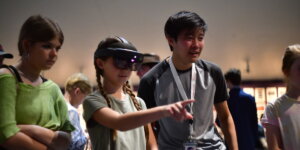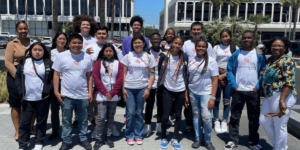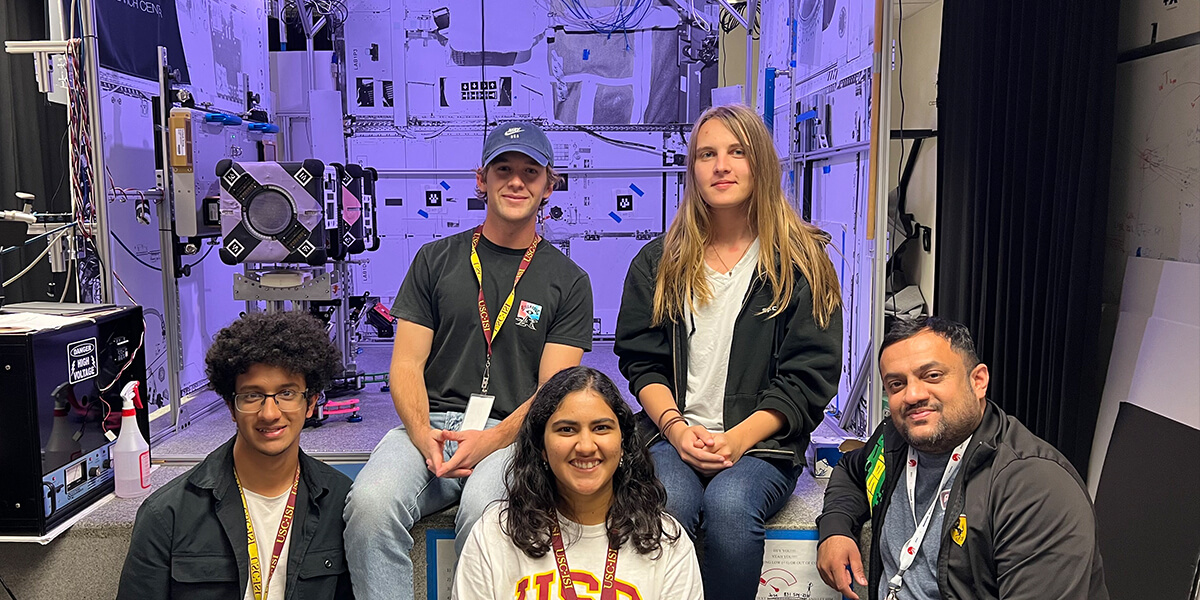
USC students build and test the CLINGERS experiment before it flies to space. Pictured from left: Sami Haq, Henry Adam, Shobhita Rajashekar, Julia Schatz, Adarsh Rajguru
On June 5, a Falcon 9 rocket launched from Cape Canaveral Space Force Station in Florida with a very special cargo: CLINGERS, USC’s first experimental research prototype to be tested on board the International Space Station.
CLING is a docking system originally patented by Berok Khoshnevis, Louise L. Dunn Endowed Professorship in Engineering and Distinguished Professor of Civil and Environmental Engineering, Astronautics, and Aerospace and Mechanical Engineering.
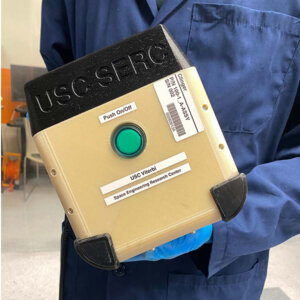
Test hardware for the CLINGERS experiment
The mechanism was initially intended for ground robots, but its applicability for astronautics soon became clear. As a genderless mechanical coupling system that can be attached to any type of vehicle or platform to make an automatic connection, CLING could be used to facilitate rendezvous and proximity operations in space. This is a key research area of particular interest to the USC Space Engineering Research Center, directed by David Barnhart.
Barnhart, the principal investigator on the research project, led a team of PhD candidates, and graduate, undergraduate and high-school students to develop a system that merges two functions involved in autonomous docking. First, the capacity to sense the range and bearing of a destination object. Second, the act of making the physical connection.
CLING stands for “Compliant Low-Profile Independent Non-Protruding Genderless System.” Add “Electronic Rendezvous Sensors,” and you have CLINGERS. This dual nature of the docking components means that identical CLINGERS hardware can be located on separate spacecraft to enable simplified sensing and efficient docking. Potential applications include transferring data, refueling a spacecraft, or assembling machinery from different parts.
“In being selected for testing on the ISS, CLINGERS transcends the ‘valley of death’ that all research is subject to,” said Barnhart. “The ability to demonstrate the applicable results of early research is crucial for making the transition to actual industry acceptance and use, a top priority for SERC.”
Once aboard the ISS, CLINGERS will be attached to its host, Astrobee (a free-floating platform developed by NASA Ames Research Lab), designed to help astronauts and researchers operate inside the ISS. If you’re imagining a bumblebee-like device hovering and helping in the hive of the ISS – you’re not far off. Two CLINGERS will be affixed to separate Astrobees and tested to perform various docking and capture procedures.
Two of the student leads on the project, Henry Adam, who was involved in software development, and Haley Topper, who managed hardware integration and testing, are both doing summer internships at NASA Jet Propulsion Laboratory (JPL). After having earned their stripes on CLINGERS, very little can faze them.
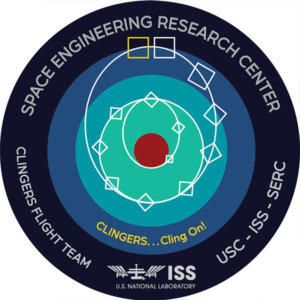
CLINGERS mission patch
“To sense where one CLINGERS unit is in relation to another, we use what’s called a perspective and point algorithm,” explained Adam, an undergraduate majoring in Astronautical Engineering. “Cameras on one unit detect LEDs on the other unit, identifying the exact distance and angle. CLINGERS sends that information to Astrobee so that it can move to that destination. The process repeats until close enough to dock. That’s experiment success.” The algorithms were perfected by a USC Ph.D. candidate Adarsh Rajguru, undergraduate student Sami Haq and two high-school students, Ezra Eyre and Melodie Ebrahim.
“It’s fantastic to have the opportunity to work on projects like this while we’re still in school,” said Topper, a Master’s student studying Astronautical Engineering. “My job involved making sure we had all the parts we needed and managing a team who could build the units, integrate the software and formulate testing procedures. All those hours in the cleanroom were worth it in the end. How many people get to say that they built something that’s going up to space?”
“I am incredibly proud of the students and thankful that we at ISI and USC have supported this unique opportunity,” said Barnhart. “Providing hands-on training before students graduate is a powerful way to expand their education while they are here.”
The operations will occur over the next couple of months, all subject to the onboard ISS crews’ workload and availability. The activation of CLINGERS will be live-streamed to the SERC location during operation, inviting the USC community to share in this unprecedented experience.
Published on June 2nd, 2023
Last updated on July 27th, 2023




